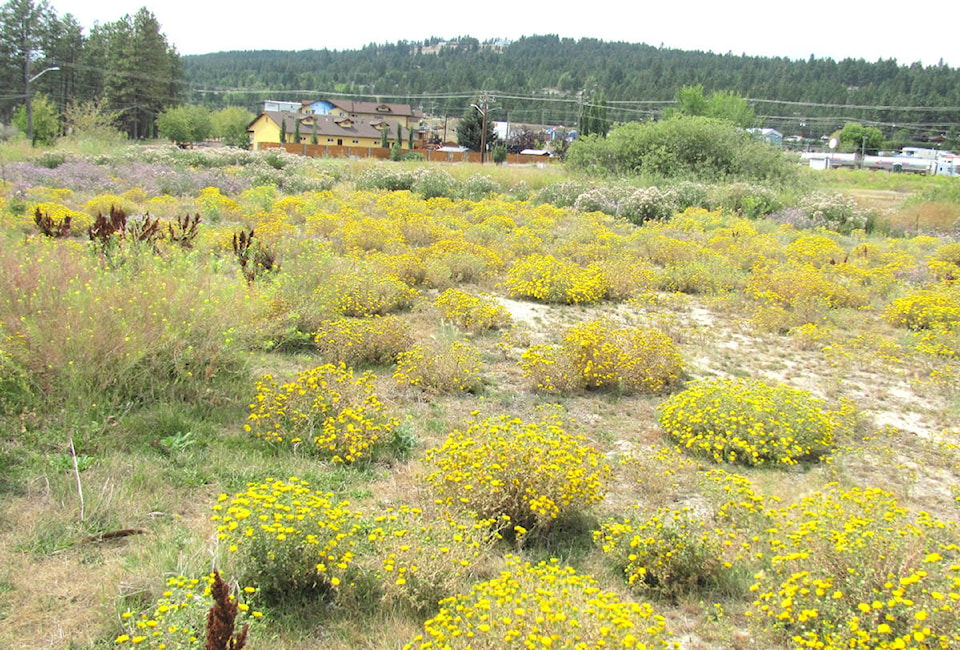Curlycup Gumweed, a medicinal herb, is going into flower locally, this week.
It first attracted my attention four or five years ago, as Gumweed seemed to be prospering on the sandy shoulders of Highway 3/95, and along streets in Cranbrook’s industrial neighbourhoods. Then two years ago, while spraying weeds for a city contractor along Wattsville Road, I saw Curlycup Gumweed had invaded the vacant lot in the photo and was dominating center stage, while known invasive weeds such as Spotted Knapweed, Curled Dock, Tumble Mustard and Canada Thistle were skulking around the edges of the scene.
So, I asked a visiting provincial weed biologist about Gumweed’s status. The response was, “It’s a native plant. We don’t worry about it.”
“But look what Curlycup Gumweed is doing in this photo,” I said.
“If there is too much on your property control it,” replied the provincial weed biologist.
“So, if it is native to B.C. what part of B.C., because it seems to be new around here,” I asked?
“Salty marshland at the coast,” the biologist said.
“Well that explains why it prospers along our local roads, considering all the salt we apply in the winter,” I thought.
Okay, if it is going to be up to me to decide my tolerance for Curlycup Gumweed, I don’t like being run over by nasty surprises, preferring to heed the advice in Johnny Cash’s song — “I hear the train a-comin, it’s rollin round the bend.”
So, when in a hurry to get an opinion on anything, the first place I turn to is Saskatchewan. Those farmers are willing to tell you what’s what.
According to a Saskatchewan Government website, Curlycup Gumweed is spreading from Ontario to B.C. It likes salty, beat-up, overgrazed soil. The website also states: cows and deer don’t eat Gumweed; starving sheep will eat some Gumweed flowers; if heavy metals, like Selenium, are in the soil, Gumweed absorbs enough metal to become poisonous.
Not a good recommendation on Curlycup Gumweed from Saskatchewan; but wanting to be fair, I got a second opinion from Canada’s older sibling — who usually gets into trouble with stuff way before we do.
The USDA website says: Gumweed likes bare roadsides and beat-up pastures and some salt in the soil; Sage grouse chicks will eat Gumweed; cows, sheep and horses do not like it; Curlycup Gumweed tastes bad.
Well, since it is using our salty shouldered provincial highway system to migrate across the landscape, the bad reports from those two sources have convinced me not to welcome Curlycup Gumweed to my neighbourhood. How about you, to where you live?
Now to the cranky part, Curlycup Gumweed is no longer growing on the vacant lot in the photo at right. All the previous plants on that lot look like they had been obliterated by drenching the lot with herbicide, the way the guy with the fire-hose applicator was seen flooding a couple of other Cranbrook area lots in previous years. That is not the way to deal with weeds responsibly!
Vacant property, treated for weed infestations, should end up looking like a restoration project — covered in grasses and wild flowers, not like the location of a chemical spill. When applying pesticide, remember the old Burma-Shave motto- “A little dab’ll do ya.” Curlycup Gumweed is taprooted and can be dug out with a screwdriver then garbage bagged for the dump. If you can’t get all the root out, a little bit of herbicide on the injured remainder of the taproot should finish the job.
The huge vacant lot, behind Walmart — that I described two weeks ago regarding Baby’s Breath, is now covered with weeds in bloom. You can see Baby’s Breath, Curlycup Gumweed and a number of other weeds multiplying there. I hope they don’t get the guy with the fire hose technique to drench that immense lot with herbicide. The misuse of powerful chemicals to flood the countryside was how irresponsible people got DDT banned last century. Having a crew quickly garbage bag the weed tops and give the remaining root-tops a spritz of herbicide, then spread grass seed, would be way more responsible.
Weed Warrior Frank
